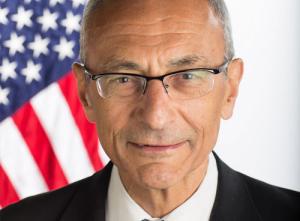The President’s Senior Advisor, John Podesta, laid out the Administration’s position on permitting reform May 10 at the Bipartisan Policy Center. The PUF team was there of course, given this topic’s critical importance.

Here’s Podesta’s speech in full:
“The permitting process for clean energy infrastructure, including transmission, is plagued by delays and bottlenecks. These delays are pervasive at every level of government, federal, state, and local.
We got so good at stopping projects that we forgot how to build things in America. It’s been this way for a while.
Last fall, I came back to the White House. In my first week on the job, in my first meeting with Secretary Granholm, the Secretary of Energy, I found out that permits for a transmission line that I thought had been resolved in the Obama Administration, in part at my urging, still hadn’t been approved ten years later. They had been awaiting approval ten years before that.
That’s just unacceptable. Given that we have to increase electric transmission sixty percent over the next seven years, which means building transmission lines at twice our current pace, we’ve got to fix this problem now.
Most Americans agree. Eighty-one percent of voters support the development of new transmission. A majority say that permitting reform should prioritize clean energy projects over fossil fuels.
That’s why President Biden has elevated this issue to the highest levels of government. For the first time, I think it’s fair to say, by forming and investing an America cabinet that meets regularly on permitting and other priority issues for infrastructure implementation at the secretarial level in the White House.
It’s why the Inflation Reduction Act invests a billion dollars in key federal permitting agencies to increase staff capacity, incorporate new technology, improve coordination, and site and permit big clean energy projects. The Bipartisan Infrastructure Law invests billions in transmission deployment.
Our Council on Environmental Quality has clarified and restored basic safeguards for environmental reviews. We’re getting those reviews done faster than the previous administration. We’ll soon be proposing additional reforms to make the environmental review process more efficient and more effective.
We’ve also released updated guidance on how to account for greenhouse gas emissions and climate. So, fewer projects get tangled up in litigation. And so they’re permitted right and built right the first time through. Not having to bounce back and forth from the agency to the court and back to the agency.
Just yesterday, the Department of Energy kicked off the process of designating national interest electric transmission corridors by releasing a notice of intent. This process unlocks DOE and for tools to accelerate the deployment of high-capacity transmission. So, we can provide clean, affordable, reliable electricity to more Americans.
And today I’m excited to announce that seven agencies, the Federal Permitting Improvement Steering Council, and the White House, have signed a new memorandum of understanding to put electric transmission permitting on a fast track. Allowing DOE to exercise its full authority under section 216(h) of the Federal Power Act to shepherd projects forward.
We’ve seen some recent wins. Like the final approval of TransWest Transmission Line that will send Wyoming wind energy to California.
I have to say this Administration is doing all we can with the tools we have. But frankly, we can use some more tools to go even further. And to go even faster.
We need Congress to give us those tools. The President has been clear over the past six months that he believes that permitting reform should pass on a bipartisan basis. He believes permitting needs to be optimized for building out a clean and secure energy economy.
President Biden is grateful for Senator Manchin’s leadership and commitment to this issue. In particular, the President supported the Senator’s permitting legislation in December. He continues to support the bill that the Senator reintroduced last week.
Congress should treat that bill, and particularly the deadlines that imposes for environmental reviews, to start serious bipartisan negotiations in the Senate. To eliminate roadblocks to clean energy projects and bolster our energy security.
The President frankly doesn’t love everything in the bill. But we support it because that’s what compromise means. It will take compromise on everybody’s part to get this done.
The Biden-Harris Administration has worked hard to better understand the roadblocks. Now we’re asking Congress to build on Senator Manchin’s legislation with additional reforms. That’s why today the White House is releasing a list of eleven priorities that Congress should include in permitting legislation.
You can read all eleven in a fact sheet that’s now live on the White House website. But let me just share a few highlights.
We’ve got to get more clean energy capacity connected to the grid by speeding up interconnection. Legislation needs to expedite the connection of generation or storage that impacts more than one transmission system. And it needs to allow clean energy project developers to pay the cost of interconnection upfront, to just speed that process up substantially.
Then we’ve got to get that clean energy where it’s needed by accelerating the deployment of transmission. And making permitting more efficient and predictable for interstate transmission projects. A key part of this is allowing projects to allocate project cost to customers that benefit from the new transmission.
Congress should give clear authority to issue permits for interstate transmission lines and to include carbon dioxide and hydrogen infrastructure in designated energy corridors. And we need to make sure that during extreme weather events, regional grids can borrow energy from other power systems to help keep the lights and heat on for American families.
To do that, Congress should direct FERC to set a minimum level of transfer capability between regional grids. And should require the consideration of multiple benefits, including economic, operational, and environmental benefits when making transmission decisions.
Congress should cut duplicative and burdensome reviews. Often environmental reviews and permitting processes are done sequentially, which can cause unnecessary delay.
Congress should address areas of overlap, including by allowing transmission projects to rely on analysis and corridor-wide programmatic environmental reviews. Federal agencies need to engage local communities early and often. A crucial ingredient to increase public buy-in for clean energy projects and build in the locations that make the most sense.
And by the way, it will avoid lengthy litigation delays if we do that right. And do that early. That support means installing chief community engagement officers at each permitting agency, establishing new funds that agencies can use to provide grants to local governments and groups, and allowing agencies to transfer funds to increase their permitting capacity.
We need to modernize our data collection and permitting technology from mapping tools to an automated permitting application system. That will help ease the burden for project developers and increase transparency so the public can track our progress.
We need specific 2030 and 2035 goals for renewable energy deployment on public lands. Congress needs to help site clean energy projects on brownfields by protecting developers from liability as long as they address contamination at the site.
On a similar note, Congress should make clear that agencies have authority to require project developers to mitigate environmental impacts. And those efforts satisfy environmental review requirements.
We’ve got to fix the cost and delays that are bogging down the licensing process for hydropower projects. Hydropower supplies thirty-seven percent of zero-carbon power in the U.S. More than thirty percent of the non-federal hydropower licenses in the United States are expected to expire by 2030.
It’s time to reform the process so we can keep this crucial energy source online. It’s long past time to update our ancient mining laws, which were written in 1872.
The Administration will make more specific recommendations on mining law reform soon. But suffice it to say that even though the memoirs of Ulysses S. Grant are still on recommended reading lists, mining legislation he signed more than a hundred and fifty years ago is a little out of date.
The Administration is serious about building a secure energy future that strengthens America’s economy if Congress is ready to do the same. If Congress is ready to do the same, they’ll pass bipartisan permitting reform that includes the White House’s priorities and accelerates clean energy deployment. And they’ll help us implement and expand on President Biden’s investing in America agenda, in trying to undo some of its most impactful provisions.
Through their “Default on America Act,” House Republicans have voted to repeal the Inflation Reduction Act’s clean energy tax credits. If they have their way, they’ll send tens of thousands of new manufacturing jobs back overseas, many from their own districts. If that bill were to be enacted, it would increase energy costs, and increase taxes on hardworking families who are expecting to get a credit or a rebate for installing a heat pump or rooftop solar.
And by repealing the foreign entities of concern requirements for the IRA’s clean vehicle tax credit, they’ll make sure that EVs of the future are powered by Chinese batteries and critical minerals. Instead of those made in America.
Simply put, the House Republican Plan would be catastrophic for our economy, our energy security, and our national security. They’re proposing to endanger the health of Americans, undo our clean energy progress, as ransom for not triggering a catastrophic default.
Right now, we’re in the midst of a climate crisis. One that demands that we build, build, build clean energy.
We could do it in a way that protects ecosystems and communities, creates good paying jobs, makes our nation more competitive, and saves our planet. Here’s the bottom line. If we can’t build some new things in a few backyards, the climate crisis will destroy everyone’s backyards along with the livelihoods, communities, wildlife and biodiversity we all want to protect.
I may not be popular among my friends in the environmental movement for saying that. But that is the reality.
The general tactic used by opponents of projects, delay it until it goes away, is in effect a form of climate denial. Those aren’t my words. That’s what Bill McKibben, one of our nation’s leading environmentalists, wrote in Mother Jones last month.
He then said, when you’re in an emergency, acting, at least, gives you a chance. Not acting guarantees an outcome. And not a good one.
It’s time that we act. It’s time that we confront crisis with pragmatism to go from stopping things to building things again. With pragmatic bipartisan action from Congress, we can build a secure, resilient, affordable, clean energy future together.”


